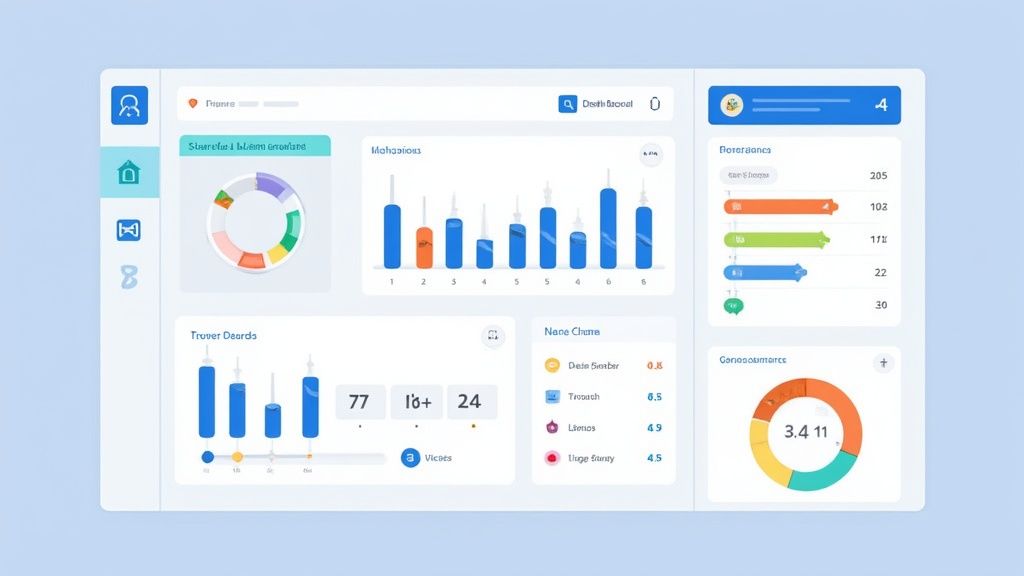How to Set Up Alerts: Your Step-by-Step Guide
In a data-saturated world, reacting to events as they occur means you're already playing catch-up. The skill of setting up intelligent alerts distinguishes experts from novices. This enables you to shift from passive observation to proactive action, potentially granting you a competitive advantage.
It's about converting vast streams of information into timely, actionable insights.
Why Excelling in Alerts Provides an Advantage

Developing an advanced alert system is crucial. A well-designed setup that monitors market dynamics, brand discussions, or competitor actions offers significant benefits. It allows you to anticipate changes rather than merely reacting to them.
This forward-thinking method is changing work dynamics. For instance, marketers might receive immediate notifications when a competitor launches a new campaign, while traders might get signals about market fluctuations. The aim is to create a system that provides meaningful insights rather than just more data.
The Value of Proactive Monitoring
An effective alert system is more than just phone notifications; it's your personalized early-warning tool. It efficiently filters out irrelevant data, focusing on what truly requires attention. This capability turns overwhelming data streams into actionable intelligence.
When integrated with broader business process automation, alerts can trigger subsequent workflow steps, enhancing operational responsiveness.
The key advantage of a smart alert system is the reduced time between an event and your response. This is where the competitive benefit lies.
Before setting up alerts, it's essential to understand the components that make a system effective. A robust system combines intelligent triggers, clear information, and direct paths to action.
Key Components of an Effective Alert System
Considering these components helps create alerts that provide tangible value rather than digital clutter.
The Increasing Significance of Alert Systems
The demand for such technology is rapidly growing across industries. For instance, the mass notification system market, closely related to alert systems, was valued at USD 16.48 billion in 2024 and is forecasted to reach USD 69.30 billion by 2032.
This growth indicates businesses' reliance on platforms that offer real-time insights into emergencies and routine operations. Understanding these trends highlights that setting up effective alerts is crucial.
Strategize Your Alert Setup

Before configuring alerts in Flipify, it's important to develop a strategy. Without a plan, you risk being overwhelmed by irrelevant notifications.
A strong strategy differentiates a profitable alert system from one that becomes a burden. The objective is to have a system that serves your needs effectively.
The foundation is straightforward: identify what to track and why. Every alert should lead to a specific action; if not, it's merely noise.
Key Questions to Consider
To optimize your alert system, answer these critical questions before proceeding. Your responses will guide the filters and keywords you set up.
What action will I take upon receiving this alert? If a notification lacks a clear next step, it's likely unproductive. For instance, a social media manager must respond to alerts about negative comments, while a flipper should promptly contact sellers of "free couches."
How many irrelevant alerts am I willing to tolerate? Your threshold for false positives is important. A stock trader requires precise alerts, while casual furniture hunters might accept some irrelevant listings to find a valuable item.
Is this an urgent alert or a general update? Distinguish between immediate and non-urgent alerts to avoid burnout.
The objective is to receive the right alerts. Each notification should signal a defined, planned response, turning data into actionable steps.
This approach is crucial across industries. For instance, the medical alert systems market, valued at USD 9.24 billion in 2024, relies on delivering urgent, actionable alerts. North America accounts for 40% of this market, emphasizing the importance of timely information. You can explore more data on the reliance on precise alerts in this sector.
By clearly defining your goals, you ensure that every alert is focused, relevant, and impactful. A few minutes of planning can transform a cluttered data stream into a valuable intelligence source.
Now that your strategy is in place, it's time to implement it. Let's explore setting up your first alerts in Flipify with a watchlist—the core of your monitoring system.
Think of a watchlist as your personal search assistant, continuously scanning for opportunities.
A common mistake is creating a large, disorganized watchlist. Instead, develop distinct, purpose-driven watchlists for each goal. This keeps alerts organized and aligned with specific objectives, ensuring you understand the purpose of each notification.
Organizing Your Watchlists
For practical application, consider a reseller. Instead of a broad "Good Deals" list, create focused watchlists:
Competitor Activity: Track specific brands or models that competitors frequently deal with. This provides insights into their sourcing strategies.
Industry Trends: Monitor broad terms for popular categories, such as "mid-century modern furniture" or "vintage gaming consoles."
Project Sourcing: For specific projects, create temporary watchlists for niche items like "reclaimed barn wood" or "antique brass hardware."
This organization differentiates experts from novices, transforming random notifications into actionable intelligence.
Real-World Watchlist Example
Consider a new, popular gadget called the "Nova Vibe," ideal for flipping. Here's how to build a dedicated Flipify watchlist to track it.
Create a new list—"Nova Vibe Hunt"—and add search criteria:
Keywords: Start with "Nova Vibe" and "NovaVibe."
Related Tags: Include social media tags like #NovaVibe and #NovaVibeForSale.
Mentions: Add names of designers or influencers associated with the product.
Combining product names with related tags and key people broadens your search, capturing official listings and casual sellers. This approach uncovers hidden opportunities.
This structured setup ensures notifications for every potential lead, from marketplace posts to social media mentions. It's more effective than simple keyword searches and sets up alerts for real results.
Refining Alert Triggers and Conditions
Once your watchlists are established, you can refine your alerts. This step is crucial for ensuring notifications are relevant and valuable.
Instead of setting broad alerts like "free couch," refine them. Aim for alerts that notify you about a "free leather couch" with "excellent" condition in specific high-income areas. This precision filters out irrelevant notifications, ensuring alerts are worth acting on.
Utilizing Negative Keywords to Reduce Noise
A powerful tool in Flipify is the negative keyword feature, which cleans up results by excluding undesired terms in titles and descriptions. It's like precision searching rather than broad, unfocused queries.
For example, searching for "Jaguar" without refinement leads to results related to the NFL team and animals. By using Flipify's UI, you can exclude these terms, cleaning up your results.
This approach is valuable in various categories. For instance, when searching for "Trek" bicycles, eliminating terms like "kids" or "Huffy" can help focus on high-quality items.
Comparing Basic and Advanced Alert Triggers
This table illustrates the transition from basic to advanced alert triggers, ensuring each notification is relevant and valuable.
| Trigger Type | Basic Setup Example | Advanced Setup Example | Best For | | --- | --- | --- | --- | | Keyword | "iPhone" | "iPhone 13 Pro Max -unlocked -cracked" | Targeting specific, high-value models while filtering out damaged or irrelevant listings. | | Price | $0 - $100 | $50 - $75 | Finding underpriced items that are still in good condition. | | Location | 20-mile radius | Specific affluent areas | Sourcing quality items from areas likely to offer high-value goods. | | Combined | "Free Furniture" | "Free -couch -sectional +solid +wood +vintage" in a specific area | Locating valuable non-upholstered furniture while excluding common items. |By combining these advanced triggers, you're not just searching; you're creating a focused deal-finding tool.
Tip: Continuously refine negative keywords using Flipify's UI. Monitor alerts for irrelevant items and adjust keywords accordingly. It's an ongoing refinement process.
This level of control is critical for success. It's not about seeing every opportunity; it's about seeing only the right ones. By carefully layering keywords, price ranges, and location filters, alerts become precise.
Matching Channel to Alert Urgency
Not every alert requires immediate attention. A daily summary of "vintage dressers" doesn't need the same urgency as a rare gaming PC listing. Your system should inform you without overwhelming you.
Here's a simple breakdown for watchlists:
Instant Alerts: Reserve for high-priority, time-sensitive items like rare collectibles or specific models.
Team Integrations: Use platforms like Slack or Discord for team-based flipping, keeping personal alerts minimal.
Daily Email Summaries: Ideal for research and lower-priority lists, providing trends without constant interruptions.
This tiered approach is crucial. The medical alert systems market, valued at USD 6.5 billion in 2020, exemplifies the importance of timely, effective alert delivery.
Aim for an alert system where each notification has a clear purpose and delivery method. This supports decisive action on significant opportunities.
Common Questions About Alert Setup
As you refine your alerts, consider these common questions for optimization:
Cutting through noise often involves specifying search terms. Instead of broad terms like "Chair," use detailed phrases and Flipify's UI to exclude irrelevant content, cleaning up your feed.
Timing is another consideration: real-time alerts are crucial for high-demand items, while daily digests suit broader research.
Power lies in layering settings. Combining specific searches with price and location filters transforms a noisy feed into a curated opportunity list.
Traders often use specialized tools alongside flipping strategies. Exploring day trading alerts services can offer additional insights. For local marketplaces, our guide on setting up Facebook Marketplace alerts is invaluable for targeting profitable searches.
Ready to stop missing deals and start flipping smarter? Let Flipify build your custom, real-time alert system today. Start your free trial at https://flipifyapp.com and gain the advantage you're seeking.